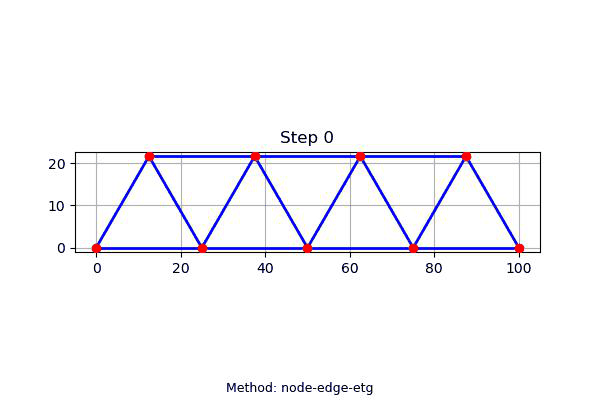This repository contains the Python implementation for the paper: EvoDevo: Bioinspired Generative Design via Evolutionary Graph-Based Development as part of RIED project. It specifically focuses on the Cartesian Genetic Programming (CGP) methods discussed in the paper for optimising the design of truss structures.
This work presents a bio-inspired generative design algorithm that uses the concept of evolutionary development (EvoDevo). Instead of directly optimising a design, this approach evolves a set of reusable developmental rules.
The core of this system is an artificial Gene Regulatory Network (GRN), which acts as a controller within simple entities called "cells". For a truss structure, these cells represent the nodes (vertices) and edges (members). Each cell's GRN senses its local environment (e.g., strain energy, volume) and outputs a "growth" command, such as moving a node or changing an edge's cross-sectional area.
This repository implements the CGP-based GRN, which offers more interpretable, "white-box" outputs compared to neural network alternatives like GNNs. The goal is to evolve a controller that can effectively optimise a truss structure over a series of developmental steps.
- Evolutionary Development (EvoDevo): An indirect approach to design where the "designer" (the GRN) is evolved, not the design itself.
- Cartesian Genetic Programming (CGP): A graph-based evolutionary algorithm used to create readable and efficient GRN controllers.
- Cellular Representation: The truss is broken down into node and edge cells, each with its own controller that makes local decisions to achieve a global objective.
- Multiple Growth Mechanisms: The system can optimise trusses by:
- Adjusting the cross-sectional area of edges (
edge-onlymethod). - Moving the coordinates of nodes (
node-onlymethod). - Doing both simultaneously (
node-edgemethod).
- Adjusting the cross-sectional area of edges (
- Fitness Function: The evolutionary algorithm optimises controllers based on a fitness score that combines the total strain energy and total volume of the truss.
This project uses Conda to manage its environment and dependencies. You'll need to have Anaconda or Miniconda installed.
-
Clone the repository:
git clone [https://github.com/Tahernezhad/Cartesian-Genetic-Programming-for-Truss-Optimization.git](https://github.com/Tahernezhad/Cartesian-Genetic-Programming-for-Truss-Optimization.git) cd Cartesian-Genetic-Programming-for-Truss-Optimization -
Create the Conda environment: Use the provided
environment.ymlfile to create the Conda environment. This will install all the necessary packages and dependencies.conda env create -f environment.yml
-
Activate the environment:
conda activate cgp
To run the evolutionary algorithm, execute the main.py script:
python main.pyEnvironment modelling concepts originate from the RIED project (GitLab): https://gitlab.com/riedproject
